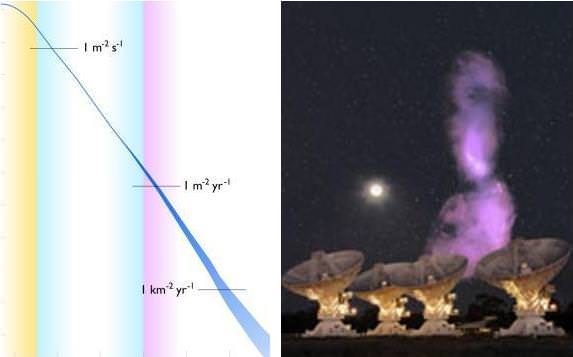http://www.universetoday.com/86490/astronomy-without-a-telescope-oh-my-god-particles/#more-86490 wrote:
Astronomy Without A Telescope – Oh-My-God Particles
by Steve Nerlich on June 12, 2011
<<Cosmic rays are really sub-atomic particles, being mainly protons (hydrogen nuclei) and occasionally helium or heavier atomic nuclei and very occasionally electrons. Cosmic ray particles are very energetic as a result of them having a substantial velocity and hence a substantial momentum.
The Oh-My-God particle detected over Utah in 1991 was probably a proton traveling at 0.999 (and add another 20 x 9s after that) of the speed of light and it allegedly carried the same kinetic energy as a baseball traveling at 90 kilometers an hour.
Its kinetic energy was estimated at 3 x 10
20 electron volts (eV) and it would have had the collision energy of 7.5 x 10
14 eV when it hit an atmospheric particle – since it can’t give up all its kinetic energy in the collision. Fast moving debris carries some of it away and there’s some heat loss too. In any case, this is still about 50 times the collision energy we expect the Large Hadron Collider (LHC) will be able to generate at full power. So, this gives you a sound basis to scoff at doomsayers who are still convinced that the LHC will destroy the Earth.
Now, most cosmic ray particles are low energy, up to 10
10 eV – and arise locally from solar flares. Another more energetic class, up to 10
15 eV, are thought originate from elsewhere in the galaxy. It’s difficult to determine their exact source as the magnetic fields of the galaxy and the solar system alter their trajectories so that they end up having a uniform distribution in the sky – as though they come from everywhere.
But in reality, these galactic cosmic rays probably come from supernovae – quite possibly in a delayed release process as particles bounce back and forth in the persisting magnetic field of a supernova remnant, before being catapulted out into the wider galaxy.
And then there are extragalactic cosmic rays, which are of the Oh-My-God variety, with energy levels exceeding 10
15 eV, even rarely exceeding 10
20 eV – which are more formally titled ultra-high-energy cosmic rays. These particles travel very close to the speed of light and must have had a heck of kick to attain such speeds.
However, a perhaps over-exaggerated aura of mystery has traditionally surrounded the origin of extragalactic cosmic rays – as exemplified in the Oh-My-God title.
In reality, there are limits to just how far away an ultra-high-energy particle can originate from – since, if they don’t collide with anything else, they will eventually come up against the Greisen–Zatsepin–Kuzmin (GZK) limit. This represents the likelihood of a fast moving particle eventually colliding with a cosmic microwave background photon, losing momentum energy and velocity in the process. It works out that extragalactic cosmic rays retaining energies of over 10
19 eV cannot have originated from a source further than 163 million light years from Earth – a distance known as the GZK horizon.
Recent observations by the Pierre Auger Observatory have found a strong correlation between extragalactic cosmic rays patterns and the distribution of nearby galaxies with active galactic nuclei. Biermann and Souza have now come up with an evidence-based model for the origin of galactic and extragalactic cosmic rays – which has a number of testable predictions.
They propose that extragalactic cosmic rays are spun up in supermassive black hole accretion disks, which are the basis of active galactic nuclei. Furthermore, they estimate that nearly all extragalactic cosmic rays that reach Earth come from Centaurus A. So, no huge mystery – indeed a rich area for further research. Particles from an active supermassive black hole accretion disk in another galaxy are being delivered to our doorstep.
 Jets from Unusual Galaxy Centaurus A
Jets from Unusual Galaxy Centaurus A


